Alpine is shaking things up in the electric sports car arena with its upcoming models, including the highly anticipated A110 and A310 fastback. The big news? These cars will feature in-wheel motors, a game-changing technology that aims to redefine how we think about performance and design in electric vehicles.
What Are In-Wheel Motors and Why Do They Matter?
In-wheel motors are exactly what they sound like: electric motors integrated directly into the wheels of the car. This innovative design offers a plethora of advantages, especially for sports cars. By eliminating the need for bulky powertrains and traditional engine placements, manufacturers can create lighter, more agile vehicles. Luca de Meo, CEO of Renault Group, emphasized that this shift could lead to a significant reduction in weight—up to 250 kg compared to conventional electric sports cars. Imagine a vehicle that feels nimbler and more responsive on the road!
Laurens van den Acker, Renault Group’s design head, pointed out that with motors in the wheels, designers can free up valuable space inside the car. This means more room for luggage, better footwell design, and even more adjustable seating. For a brand like Alpine, which aims to appeal to a broader audience, these enhancements are crucial. The A110 has been a beloved weekend car, but the A310 is set to cater to everyday drivers looking for a sporty yet practical option.
How Will This Technology Change the Driving Experience?
The introduction of in-wheel motors isn’t just about space; it also opens the door to advanced driving technologies. One of the standout features is torque vectoring, which allows for individual control of each wheel. This means that the car can adjust power distribution based on driving conditions, enhancing stability and performance. Alpine has already showcased this technology in its new A390 electric crossover, which uses two inboard motors at the rear.
However, it’s not all smooth sailing. In-wheel motors do come with challenges, such as increased unsprung weight and potential durability issues when navigating rough terrain. While the concept has been explored in various prototypes, including the Nissan Bladeglider and the now-defunct Lordstown electric pickup, it hasn’t yet made a significant leap into mass production.
What’s Next for Alpine and In-Wheel Motors?
Alpine is planning to roll out three or four models based on its new APP (Alpine Performance Platform), which includes the A310—a four-seat sports sedan designed to compete with heavyweights like the Porsche Taycan. The excitement surrounding these developments is palpable, especially with the promise of a lighter, more responsive driving experience.
Interestingly, parent company Renault is set to debut in-wheel motors in the upcoming Renault 5 Turbo 3E, a limited-production electric hyper-hatchback. This model will feature two rear-mounted in-wheel motors that collectively produce an astonishing 3540 lb-ft of torque. It’s a bold move that suggests Renault is betting big on this technology, and the success of the Turbo 3E could pave the way for broader adoption across the industry.
What Do Experts Say About the Future of In-Wheel Motors?
Industry experts are optimistic about the potential of in-wheel motors. Companies like Protean are already working on fifth-generation models and predict that the global market for this technology could reach €20 billion by the middle of the next decade. However, the high costs associated with production remain a hurdle that manufacturers will need to overcome.
The big takeaway? Embracing in-wheel motors isn’t just about creating lighter cars; it’s about reimagining the driving experience itself. As Alpine and other manufacturers push forward with this technology, we can expect a new era of electric vehicles that are not only faster and more efficient but also more enjoyable to drive. So, keep an eye on Alpine’s upcoming releases—this could be the start of something truly revolutionary in the world of sports cars.

